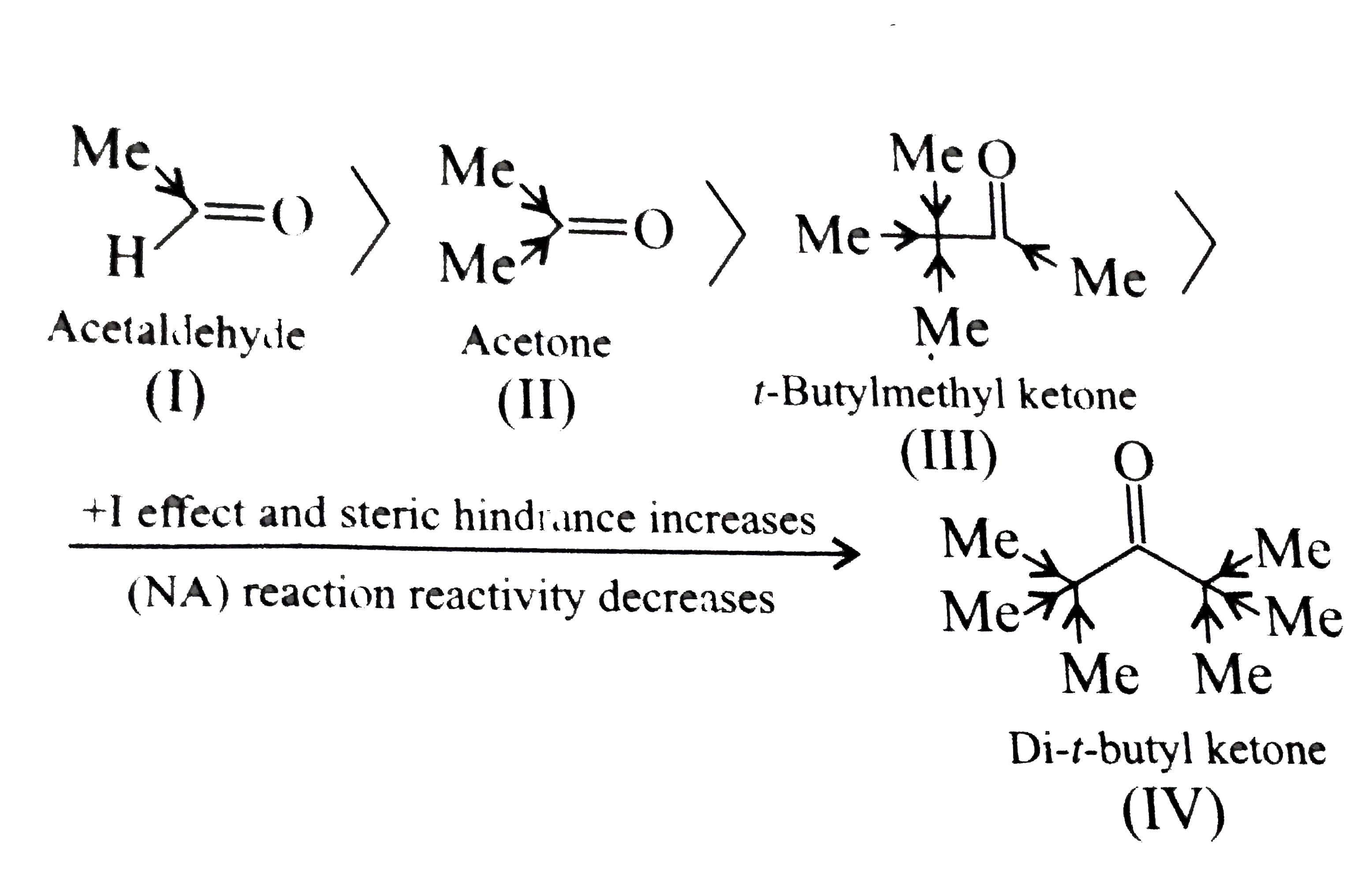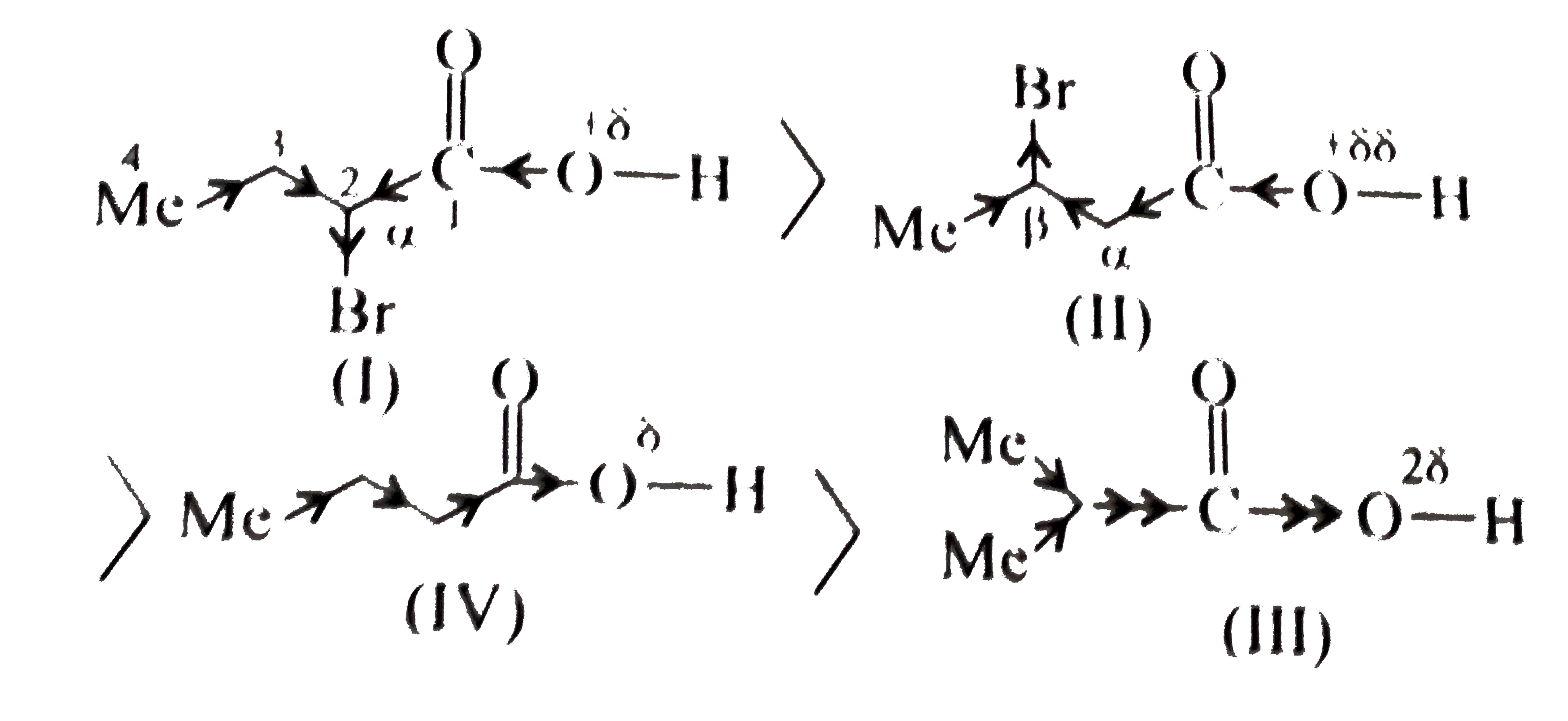Arrange the following compounds in the increasing order of their property as indicated:
i. Acetaldehyde, acetone, di-tert-butyl ketone, methyl tert-butyl ketone (reactivity towards HCN).
ii. (acidic strength).
iii. Benzoic acid, 4-nitrobenzoic acid, 3,4-dinitro-benzoic acid, 4-methoxybenzoic acid (acidic strength).
i. More -withdrowing group favours NA reaction (nucleophilic addition reaction), whereas -donating group decreases reactivity towards NA reaction or reactivity towards HCN.
Decreasing order of NA reactivity:

So, Increasing order of reactivity towards HCN:
(IV)lt(III)lt(II)lt(I).
ii. a. EWG (-withdrawing groups) increases the acidic strength, whereas EDG (-donating groups) decreases the acidic strength.
b. Nearer is the EWG to the source group], stronger is the acid, i.e., -substituted halo acid stronger than - or -substituted halo acid.
Decreasing order of acidic strength:

Increasing order of acidic strength:
(III)lt(IV)lt(II)lt(I).
iii. Decreasing order of acidic strength:

So, Increasing order of acidic strength:
(IV)lt(I)lt(II)lt(III).
Topper's Solved these Questions
- ALIPHATIC AND AROMATIC ALDEHYDES AND KETONESBOOK - CENGAGE CHEMISTRYCHAPTER - ALIPHATIC AND AROMATIC ALDEHYDES AND KETONESEXERCISE - Exercises Linked Comprehension
59 Videos
- ALIPHATIC AND AROMATIC ALDEHYDES AND KETONESBOOK - CENGAGE CHEMISTRYCHAPTER - ALIPHATIC AND AROMATIC ALDEHYDES AND KETONESEXERCISE - Exercises Multiple Correct
40 Videos
- ALIPHATIC AND AROMATIC ALDEHYDES AND KETONESBOOK - CENGAGE CHEMISTRYCHAPTER - ALIPHATIC AND AROMATIC ALDEHYDES AND KETONESEXERCISE - Exercises Subjective
52 Videos
- ALCOHOL,PHENOL AND ETHERSBOOK - CENGAGE CHEMISTRYCHAPTER - ALCOHOL,PHENOL AND ETHERSEXERCISE - Archives Analytical And Descriptive
15 Videos
- AMINESBOOK - CENGAGE CHEMISTRYCHAPTER - AMINESEXERCISE - QUESTION BANK
1 Videos
Similar Questions
Arrange the following compounds in the increasing order of their property as indicated:
i. Acetaldehyde, acetone, di-tert-butyl ketone, methyl tert-butyl ketone (reactivity towards HCN).
ii. CH3CH2CH(Br)COOH,CH3CH(Br)CH2COOH,(CH3)2CHCOOH,CH3CH2CH2COOH (acidic strength).
iii. Benzoic acid, 4-nitrobenzoic acid, 3,4-dinitro-benzoic acid, 4-methoxybenzoic acid (acidic strength).
View SolutionArrange the following compounds in increasing order of their property as indicated :
(i) Acetaldehyde, Acetone, Di - tery - butyl ketone, Methyl tert - butyl ketone (reactivity towards HCN)
CH3CH2CH(Br)CH2COOH,(CH3)2CHCOOH,CH3CH2CH2COOH( acid strength).
(iii) Benzoic acid, 4 - Nitrobenzoic acid, 3, 4 - Dinitrobenzoic acid, 4 - Methoxybenzoic acid (acid strength).
View Solution
Knowledge Check
Arrange the following compounds in decreasing order of acidity :
CH3CH2OH
H2C=CH2AR>Q>P>SBQ>R>P>SCS>R>Q>PDQ>P>R>S
Give chemical tests to distinguish between
(i) Propanal and propanone
(ii) Benzaldehyde and acetophenone
(b) Arrange the following compounds in an increasing order of their property as indicated :
(i) Acetaldehyde, Acetone , Methyl tert-butyl ketone (reactivity towards HCN)
(ii) Benzoic acid ,3,4-Dinitrobenzoic acid , 4-Metthoxybenzoic acid (acid strength)
(iii) CH3CH2CH(Br)(COOH),CH3CH(Br)CH2COOH,(CH3)2CHCOOH (acid strength)
View SolutionArrange the following compounds in increasing order of their property as indicated :
(i) CH3COCH3,C6H5COCH3,CH3CHO(reactivity toward nucleophilic addition reaction))
(ii) Cl−CH2−COOH,F−CH2−COOH,CH3−COOH( acidic character)
View SolutionArrange the following compounds in the increasing of their acid strength :
(I)(a)CH3CH2CH(Br)COOH(b)CH3CH(Br)CH2COOH(c)(CH3)2CHCOOH,(d)CH3CH2COOH
(ii ) (a) Benzonic acid ( b ) p-nitrobenzonic acid ( c ) 3,4- dinitrobenzoic acid ( d ) 4- methoxybenzoic acid
View Solution(a) Arrange the following in an increasing order of their indicated property.
(i) Benzoic acid ,4- Nitrobenzoc acid ,3,4 - Dinitrobenzoic acid, 4- Methoxybenzoic acid (acid strength)
(ii) CH3CH2CH(Br)COOH,CH3CH(Br)CH2COOH,
(CH3)2CHCOOH,CH3CH2CH2COOH (acid strength)
(b) How would you bring about the following conversions :
(i) Propanone to propene
(ii) Benzoic acid to Benzaldehyde
(iii) Bromobenzene to 1- phenylethanol
View SolutionArrange the following in order of decreasing of acid strenth indicated ?
(i) Benzoic acid, 3, 4-Dinitrobenzoic acid, 4-Methylbenzoic acid ltbgt (ii) CH3CH2CH(Br)COOH,CH3CH(Br)CH2COOH,(CH3)2CHCOOH
View SolutionArrange the following as stated :
'Increasing order of acidic strength'.
ClCH2COOH,CH3CH2COOH,ClCH2CH2COOH,(CH3)2CHCOOH,CH3COOH.
View SolutionArrange the following in increasing order of acid strength :
(i) CH3CH2CH(Br)COOH , (ii) CH3CH(Br)CH2COOH , (iii) CH3COOH
View Solution
